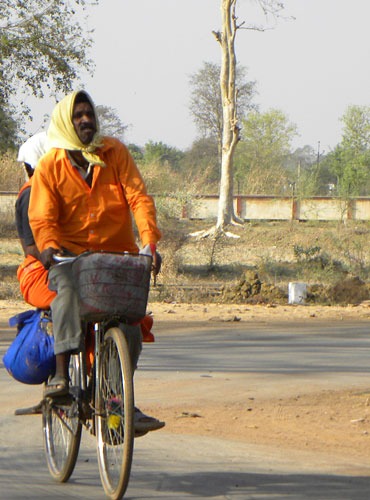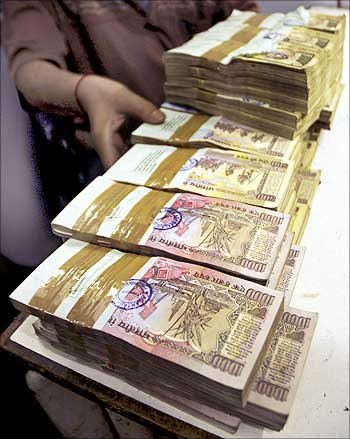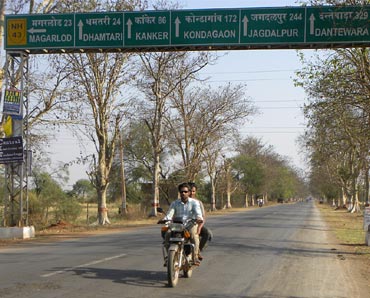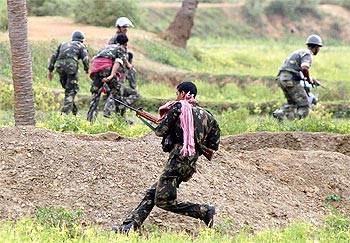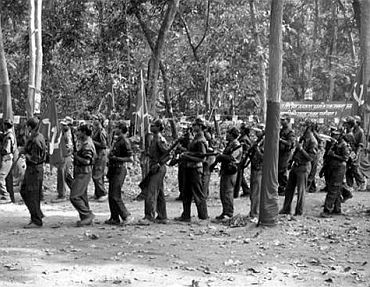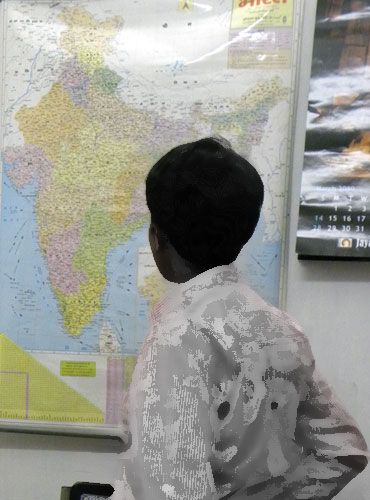 | « Back to article | Print this article |
How companies sell in Naxal areas
Potanara is a village 40 km on the road from Bastar to Jagdalpur. It is small and dusty; the villagers, men and women, old and young, all look impoverished.
There are not more than five shops along the road that sell everything from soap to biscuits, torches, batteries and, believe it or not, packaged water. Kinley or Aquafina, Kanhaiya Lal, the shopkeeper, wants to know.
This is the heart of the Naxal belt -- Dandkaranya, the so-called Red Corridor, the darkest threat to internal security -- and perhaps the last outpost for salesmen and their brands. "Go a little further and you won't find even this," Lal looks at the wares in his small shop.
Officially, almost 220 districts in Chhattisgarh, Orissa, Jharkhand and West Bengal are Naxal-affected. The government claims that it is in control but cautions people not to travel there after dark.
Click NEXT to read on . . .
How companies sell in Naxal areas
Enumerators will not go to about 200 villages in West Bengal and Chhattisgarh for Census 2011 because the Naxals have decided to boycott it. Security personnel, though armed to the teeth, are the hunted here.
Is this area a black hole for makers of FMCGs, motorcycles, mobile phones and consumer electronics? Is the pot of gold at the bottom of the pyramid inaccessible in these areas?
Call it ingenuity or jugaad, but companies and their salesmen have learnt how to do business in these villages and hamlets.
Companies do not sell themselves here - they go through wholesalers and distributors. These free agents work for several companies at the same time.
Click NEXT to read on . . .
How companies sell in Naxal areas
Raipur, the capital of Chhattisgarh, has about 30 of them. It is their job to reach the stocks over the last mile. Of course, there is no merchandise for the retailers, no samples for buyers.
The absence of the mass media means there is little brand managers can do here. The wholesalers and distributors have their own logistics and perhaps their own network of informants. Fakes abound in the markets -- protection of intellectual property means nothing here.
Travelling salesmen are often advised not to disclose their company's name in hotel registers and enter their address of residence; they could otherwise become easy targets at a time when the air is thick with suspicion and the climate is inclement for business.
The population of the Naxal-affected areas is about 4.5 million -- not a small market, though poverty is rampant. Stuff is retailed through Al Fresco haats (village shops) -- soap, detergent cake, torch, batteries, biscuits, pots and pans, and even aerated beverages.
Click NEXT to read on . . .
How companies sell in Naxal areas
The numbers are puny. Harish Tyagi, a Hero Honda dealer in Jagdalpur, sends bikes once a month to Dantewada and Bijapur on trucks -- not more than 15 at a time -- to the haat. "The market is very small, and in a quarter we sell less than 50 bikes," he says.
The evidence on the ground is mixed, though. While there is every sign of grinding poverty in the villages, the towns of Bastar and Jagdalpur have big and bustling markets.
There is even a mall coming up in Jagdalpur -- it was, in fact, supposed to be ready in 2009. "Chhattisgarh," says Kannan Sitaram, the operating partner of India Equity Partners and former COO of Dabur India, "has grown at 11-12 per cent per annum in the last few years. Though on a small base, it's better than the national average of 8 to 9 per cent."
Still, it doesn't always work smoothly. Abdul Jabbar, the main distributor of Hindustan Unilever in Bastar, says there are days when he can't send supplies to the Bijapur-Dantewada-Gidam belt.
Click NEXT to read on . . .
How companies sell in Naxal areas
"It all depends on how they are feeling," he says. 'They' are the Naxals who block highways and don't let anyone pass through. He recounts a story when people in Bijapur survived on potatoes for six days.
"They didn't let any vehicle cross, and people had no option but to make do with what they had." The Naxals have their own network of informants to keep a close watch on the movement of goods in the area.
Several wholesalers and distributors appoint middlemen who know how to 'find their way'.
Of course, it isn't easy to track down these elusive but vital go-betweens. Prosonjit Sen, the sales manager of ConAgra, admits he rarely faces any problem.
Click NEXT to read on . . .
How companies sell in Naxal areas
"We have a middleman who ensures that the supplies reach on time," says he. The distributors make sure that the middlemen are happy and pay them handsomely. These payments depend on the value of goods being transported.
For instance, a vendor of mobile phones will barter a few handsets or sometimes pay cash close to Rs 10,000 for their services.
Perfetti Van Melle, the country's largest confectioner, has worked out a new sales model. Its super-stockist in Jagdalpur supplies to about 10 sub-stockists in the affected areas.
Each of these, in turn, has on his rolls two or three 'pilot salesmen' -- local boys who travel on cycles, buses or even motorcycles to tiny villages on about 15 days a month. For security reasons, they are given a fixed travel plan.
Click NEXT to read on . . .
How companies sell in Naxal areas
Each is paid around Rs 10,000 a month with incentives for good performance. "We are doing good business in Dantewada," says Perfetti Van Melle's head of sales, Chironmoy Chatterjee.
"Each of the sub-stockists gives us sales of Rs 20,000-30,000 per month." His own team usually goes only up to Jagdalpur.
Of course, it is tough for companies to find volunteers to work here. Students in business schools have second thoughts when they are told they will have to serve in Naxal areas. So, it makes sense to employ local lads.
A police officer, who has served in the area for two years now, claims that FMCGs, automobiles and mobile phones face no trouble in the Naxal areas.
Click NEXT to read on . . .
How companies sell in Naxal areas
"But no construction material ever reaches its destination," he says. The import is clear -- development, even if it is represented by pucca buildings, could harm the Naxal cause.
The same is true of fuel retailers. State-owned Bharat Petroleum operates only one petrol pump in the area. "It's not easy to convince our drivers to go there," says a Bharat Petroleum executive based at Raipur.
Though the station has never run dry, it remains the company's least-selling pump in the state.
From Kanker, which is 150 km short of Bastar, the stunted tree trunks in the forest which runs along the road are unmistakable -- the trees were felled to block traffic. "They don't want development of any kind," says the police officer.
Click NEXT to read on . . .
How companies sell in Naxal areas
The disruptions have ensured that another sector remains in pain -- education. The Naxals ensure that not many books reach the schools.
Brijesh Pal, a Jagdalpur-based publisher who has a contract for NCERT books, says that his warehouse is full of unsold books. At times, when he tried sending books, all that came back was his driver.
"He was fortunate to have come back in one piece," he says. What happened to the books and blackboards is anyone's guess. The answer perhaps lies in the school buildings destroyed by the Naxals.
Banks are another story. Jabbar says that to withdraw amounts of more than Rs 15,000, one has to give the bank a notice of at least three days. In fact, notes of Rs 1,000 and Rs 500 are rare to find. Prashant Babu, the divisional manager of State Bank of India, says that he can't reveal how the money is transported to those areas but confirms that once or twice there have been problems.
Click NEXT to read on . . .
How companies sell in Naxal areas
"But we have got to make sure that we serve our customers there," he says. There were reports that banks have had to airdrop money in these areas but Babu doesn't want to divulge confidential information.
On National Highway 43 to Bastar you will not find many dhabas. Equally conspicuous by their absence are government-owned buses. There's one thriving dhaba just before Kanker in a village called Makadi.
Bunty Singh, a Sikh settled in Makadi for over 50 years, has seen the area change before his eyes. His dhaba even has bottles of Qua!
"There are a lot of foreign travellers, and since we are the only good place to eat, we make sure we keep the best of everything," says Singh.
Click NEXT to read on . . .
How companies sell in Naxal areas
The foreign travellers are often from UNICEF or NGOs who visit from time to time to see how the tribes live. At times, these NGOs help to supply medicines to these areas -- something that hasn't gone down too well with the state government.
Two weeks back, the government had issued a stern statement saying that this could be dangerous for them. Singh is aware that informants come and eat at his dhaba and give an update to the Naxals all the time.
If NGO functionaries or government officers eat at his dhaba, the information is relayed to the Naxals in no time.
Undeterred, the companies march on -- just like the intrepid boxwallas of a couple of generations ago.



